After seeing a manuscript of On the Origin of Species in April 1859, the Rev. Whitwell Elwin suggested that Darwin write about pigeons instead.
“This appears to me an admirable suggestion,” he wrote. “Everybody is interested in pigeons.”
After seeing a manuscript of On the Origin of Species in April 1859, the Rev. Whitwell Elwin suggested that Darwin write about pigeons instead.
“This appears to me an admirable suggestion,” he wrote. “Everybody is interested in pigeons.”
An odd feature from the Baltimore Sun of Oct. 5, 1902: Alfred Hermann of Bakersfield, Calif., pledged to circle the world in a year and a half wearing a pair of steel handcuffs, and to earn a livelihood while doing so. If he succeeded, his friend Al Armstrong agreed to finance a medical education for him.
At the time of the interview, Hermann had reached the East Coast six months after setting out from California on March 22, having visited Los Angeles, San Francisco, Seattle, Salt Lake City, Denver, Kansas City, St. Louis, Chicago, Philadelphia, and New York. “From here I ship to London, and from there go to Paris. After leaving Paris I intend to visit Berlin. At St. Petersburg I will connect with the Trans-Siberian railway and reach the west coast of China,” whence he planned to continue to Japan and embark for San Francisco. His only means of earning money along the way was to sell pictures of himself and give “exhibitions of the different exercises that it is possible for a man to take with his hands steel-braceletted.”
Under the terms of the agreement, Hermann could remove the manacles at night, “for health’s sake.” “At each stopping place the cuffs are unlocked, when he retires, by some responsible person, preferably the landlord of the hotel where he stays. Upon departing the landlord locks the cuffs, seals a bit of paper over the key opening, writes his name thereon and also writes his name in a book that Hermann carries, with the name of place, date, etc., affixed in regular postmark form. The key is then placed in Hermann’s pocket.”
I don’t know whether he made it. “The boy’s got grit in him,” Armstrong said. “I like his pluck; but, of course, he doesn’t stand much chance of winning. His enthusiasm will be likely to give out when he’s up against it in China or Russia or some other outlandish place where nobody understands the American lingo and will lock him up for a lunatic or a jailbird. However, I’ll make good if he will.”
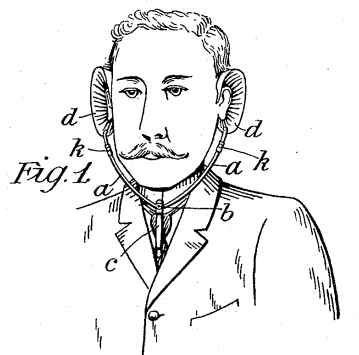
Pauline Klaws patented this “appliance for assisting the hearing” in 1902. “It is designed to be worn at lectures, concerts, theaters, and meetings by persons having defective hearing and by the people generally who at such entertainments or meetings, particularly large meetings, are unable or have difficulty in hearing a speaker.”
By 1993 this had evolved into the version below, patented by Mark Tilkens, who found it “particularly useful in hunting of game such as deer, to enhance a person’s ability to hear noises which otherwise may be drowned out by background noise.”

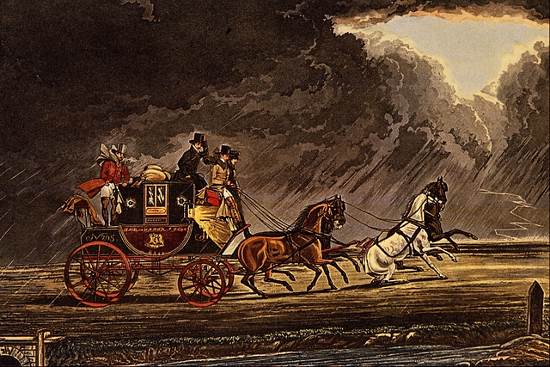
Literature often inspires music, but the reverse is less common. Here’s an intriguing exception: In Music and Literature: A Comparison of the Arts (1948), Calvin S. Brown argues that the third part of Thomas De Quincey’s 1849 essay “The English Mail-Coach” is deliberately structured as the literary equivalent of a musical fugue.
That part of the essay, titled “The Dream-Fugue,” tells how De Quincey’s dreams were dominated by a recent experience in which his carriage had nearly collided with that of a young woman. As De Quincey describes his dreams, the fugue subject is a group of ideas (speed, urgency, and a girl in danger of sudden death) that remain static while the shifting settings and details act as a contrapuntal accompaniment: In the first section a girl dances on a ship that is run down by another ship; in the second she escapes; in the third she runs along a shore and is engulfed in quicksand.
[The] middle part begins with Section IV, and is constructed exactly as it should be. The news of Waterloo and victory, the coach carrying that news, the cathedral seen in the distance and rapidly approached and entered — all these are presentations of material closely connected with the subject; but there is a definite departure from the set statements of this subject found in the exposition. In the middle section we expect at least one direct restatement of the subject in addition to this episodic material; hence we look for another vision of sudden death. We are not disappointed. After a considerable interval the girl of the visions, now an infant, appears directly in the path of the coach, which is thundering up the aisle of the vast cathedral. There is a moment of suspense, and then, just as death seems certain, she vanishes. After a dramatic pause, she reappears as a full-grown woman, on an altar of alabaster, within the cathedral and yet among the clouds. On one side of her is dimly seen the shadow of the angel of death, and on the other her better angel prays for her. What we have here is simply a recurrence of the subject and answer, the counter-subject appearing with the answer only. It will be observed that the answer always saves the victim from the immediate peril presented in the subject, but keeps the idea of further danger. In the single instance where fugue-form does not demand an answer (Section III), the girl goes on to her fate.
In the book, Brown even presents a chart identifying the exposition, the development, and the final section of the fugue. “Most commentators have brushed aside the title of this section with some meaningless comment, but De Quincey’s knowledge of music and his interest in it, together with his passion for intellectual analysis, make it reasonable to suppose that his title was something more than a fanciful name. Actually, De Quincey’s method of producing the musical effect was to follow, as far as the limitations imposed by a different medium would permit, the structure of the musical form. He succeeded in following it far more closely than has been generally realized.”
linguished
adj. skilled in language
logofascinated
adj. fascinated by words
logodaedaly
n. cunning in words; “verbal legerdemain”
oligoglottism
n. limited knowledge of languages
In North Wales the Welsh word for ‘now’ is ‘rwan.’ In South Wales it is ‘rwan’ spelt backwards, viz., ‘nawr.’ It is conjectured that the first North Walian who made use of the word was standing on his head at the time, and that his pronunciation became general.
— The Cambrian, May 1901
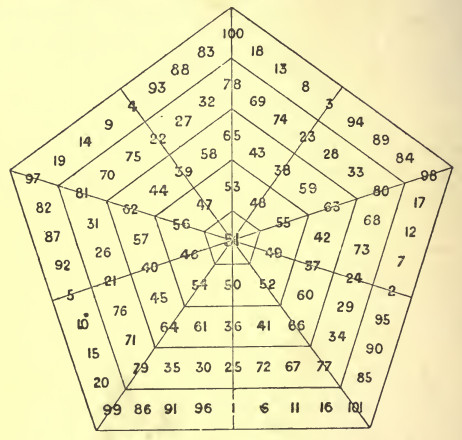
From Edward Falkener’s Games Ancient and Oriental and How to Play Them (1892), a magic pentagon. “It will be observed that the five sides of each pentagon are all equal, and that the five diameters, from one angle to the centre of the opposite side, are each 459, which is nine times the central number 51, which is also the mean number, the series being 1-101. And, further, that the inner pentagon is 510, or 10 times the mean number; the next pentagon 1,020, or 20 times the mean; the next 1,530, or 30 times the mean; and the outside pentagon 2,040, or 40 times the mean.” Evidently this was devised by Mikhail Frolov for Les carrés magiques (1886). (08/25/2015 Reader MJ has perfected this further, making each side of the outermost ring total 459, the same as the diagonals.)
From the Gentleman’s Magazine, October 1768, a “magic circle of circles” by Benjamin Franklin:

The numbers run from 12 to 75. Each ring and each radius, added to the central number 12, gives 360, the number of degrees in a circle. The dashed lines define four additional sets of circles, with centers at A, B, C, and D, each with five rings; each ring, when added to 12, also gives the total 360. (The 12 is added arbitrarily to bring the total to 360; remove it and the whole arrangement remains magic.)
From the inimitable R.V. Heath:
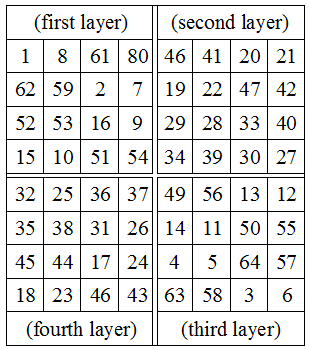
This 8×8 magic square can be cut into four smaller magic squares. When these four are stacked in the order indicated they produce a pandiagonal magic cube, each of whose rows, columns, and diagonals produces the total 130. Also: “The original eighth-order magic square has the additional property that if either set of alternate rows and either set of alternate columns be deleted — and this can be done in four ways — the remaining 16 numbers form a fourth-order magic square of magic constant 130.” (From Howard Whitley Eves, Mathematical Circles Squared, 1972.)
(Thanks, Ray.)

There was one moment in Stratford the other afternoon when I really did feel I was treading upon Shakespeare’s own ground. It was in the gardens of New Place, very brave in the spring sunlight. You could have played the outdoor scene of Twelfth Night in them without disturbing a leaf. There was the very sward for Viola and Sir Andrew. Down that paved path Olivia would come, like a great white peacock. Against that bank of flowers the figure of Maria would be seen, flitting like a starling. The little Knott Garden alone was worth the journey and nearer to Shakespeare than all the documents and chairs and monuments. I remember that when we left that garden to see the place where Shakespeare was buried, it didn’t seem to matter much. Why should it when we had just seen the place where he was still alive?
— J.B. Priestley, Apes and Angels, 1927
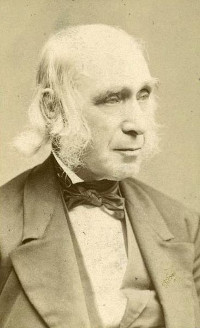
Educator Bronson Alcott punished students by making them punish him:
“One day I called up before me a pupil eight or ten years of age, who had violated an important regulation of the school. All the pupils were looking on, and they knew what the rule of the school was. I put the ruler into the hand of that offending pupil; I extended my hand; I told him to strike. The instant the boy saw my extended hand, and heard my command to strike, I saw a struggle begin in his face. A new light sprang up in his countenance. A new set of shuttles seemed to be weaving a new nature within him. I kept my hand extended, and the school was in tears. The boy struck once, and he himself burst into tears. I constantly watched his face, and he seemed in a bath of fire, which was giving him a new nature. He had a different mood toward the school and toward the violated law. The boy seemed transformed by the idea that I should take chastisement in place of his punishment. He went back to his seat, and ever after was one of the most docile of all the pupils in that school, although he had been at first one of the rudest.”
Some of this may have been wishful thinking. Alcott’s grand ideas were often poorly received, and he found it a struggle to support his family, including daughter Louisa May. He once told his mother he was “still at my old trade — hoping.”

“If I love you, what business is it of yours?” — Goethe